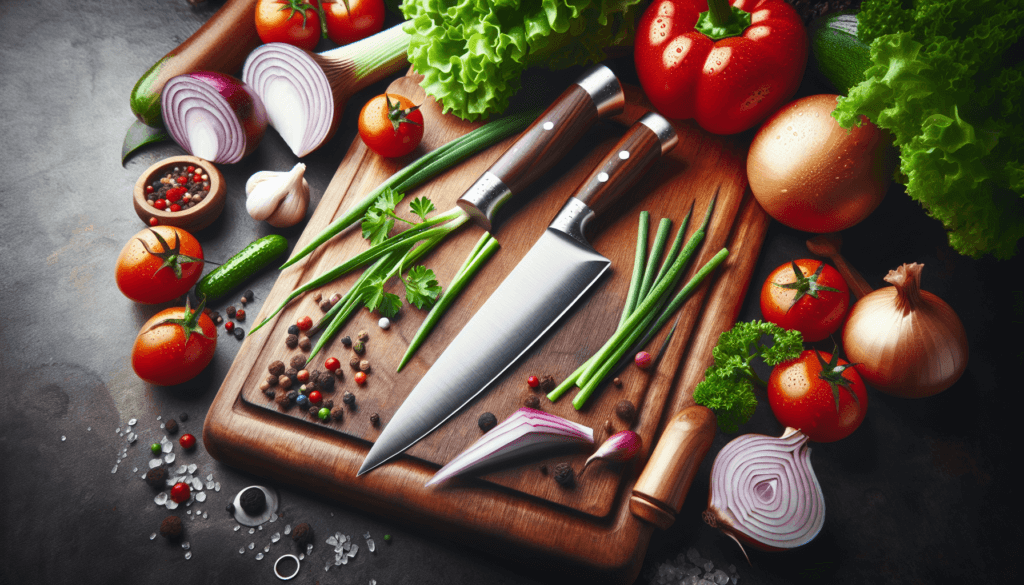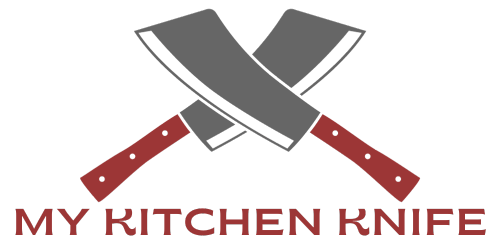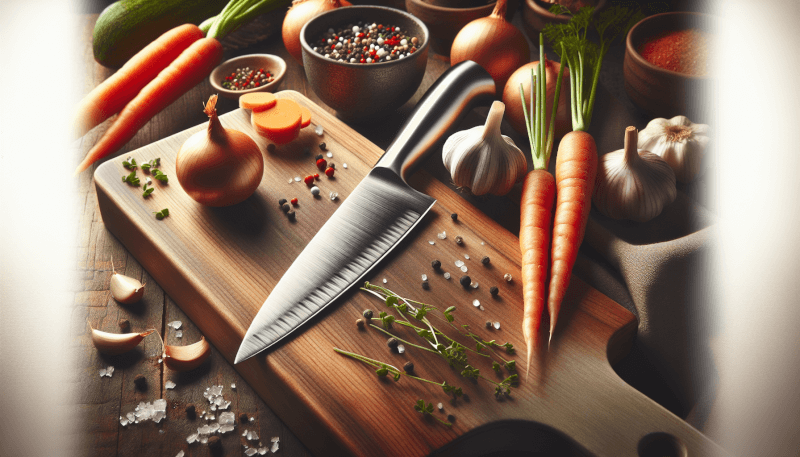If you’ve recently found yourself standing in the kitchen aisle, bewildered by the assortment of kitchen knives in front of you, fear not. This comprehensive guide has got you covered. From understanding the different types of kitchen knives to demystifying the jargon, we’ll help you navigate through the world of knives with ease. Whether you’re a complete novice or looking to upgrade your kitchen arsenal, you’ll find everything you need to know to make informed decisions and choose the perfect kitchen knives for your culinary adventures. Get ready to slice and dice like a pro!

Understanding the Different Types of Kitchen Knives
When it comes to equipping your kitchen with the right tools, having the right set of kitchen knives is essential. Each type of knife has a specific purpose, allowing you to achieve perfect cuts and make your cooking experience more efficient. In this article, we will delve into the different types of kitchen knives and explore their unique features and uses. Whether you’re a professional chef or a home cook, understanding the various types of kitchen knives will help you elevate your culinary skills to the next level.
The Chef’s Knife
The chef’s knife is undoubtedly the most versatile and essential knife in any kitchen. Also known as a cook’s knife, this multi-purpose knife is characterized by its broad blade and curved edge, enabling it to perform a wide range of tasks with ease. From chopping vegetables and slicing meats to mincing herbs and dicing onions, the chef’s knife is your go-to tool for most culinary applications. It typically ranges in size from 6 to 12 inches, and the longer the blade, the more leverage it provides for cutting through tougher ingredients.
The Santoku Knife
In recent years, the Santoku knife has gained popularity as a versatile alternative to the chef’s knife. Originating from Japan, the Santoku knife features a shorter, wide blade with a straight edge. The word “Santoku” translates to “three virtues” in Japanese, referring to its ability to perform three essential kitchen tasks well: slicing, dicing, and mincing. With its lightweight design and precise cutting capabilities, the Santoku knife is perfect for individuals who prefer a smaller and more agile knife for their everyday cooking needs.
The Paring Knife
When it comes to delicate tasks that require intricate precision, the paring knife is the ideal choice. This small knife typically has a blade length of around 3 to 4 inches and a pointed tip, allowing for intricate maneuverability and control. The paring knife is commonly used for peeling fruits and vegetables, deveining shrimp, and trimming and shaping ingredients. With its lightweight and maneuverable nature, the paring knife is a staple for any kitchen, helping you achieve intricate and detailed work effortlessly.
The Bread Knife
For crusty baguettes, chewy sourdough, or delicate pastries, a bread knife is an absolute must-have. Characterized by its long, serrated blade, the bread knife is designed to slice through crusty bread without crushing or tearing it. The serrated edge allows for a sawing motion, enabling you to glide through the crust while retaining the softness of the interior. Additionally, the bread knife can also be used for cutting cakes, tomatoes, and other delicate foods that require a gentle touch.
The Carving Knife
Whether it’s a succulent Thanksgiving turkey or a beautifully roasted beef tenderloin, a carving knife is essential when it comes to serving perfectly sliced portions. The carving knife typically has a long, thin blade with a pointed tip, allowing for precise and effortless slicing. Its sharpness and control make it ideal for slicing through large cuts of meat, ensuring even thickness and presentation. With a carving knife in your arsenal, you’ll be able to showcase your culinary masterpieces with precision and finesse.
The Utility Knife
The utility knife, also known as a sandwich knife, strikes a balance between the versatility of a chef’s knife and the precision of a paring knife. With a blade length of around 4 to 7 inches, the utility knife can handle a wide range of tasks, making it a handy tool for everyday cooking. It is perfect for slicing, dicing, and mincing smaller ingredients, such as fruits, vegetables, and boneless meats. The utility knife’s manageable size and versatility make it a popular choice for both professional chefs and home cooks alike.
The Boning Knife
When it comes to deboning meat, a boning knife is your best friend in the kitchen. This slender and highly maneuverable knife is designed to remove bones from poultry, fish, and meat with precision. With a length ranging from 5 to 7 inches, the boning knife typically features a narrow and flexible blade, allowing you to navigate around bones and joints effortlessly. The boning knife’s sharpness and agility make it an essential tool for butchers, meat enthusiasts, and anyone looking to save time and effort on their meat preparation.
The Fillet Knife
If you enjoy cooking fish or working with delicate cuts of meat, a fillet knife is a must-have in your kitchen. As the name suggests, the fillet knife is designed for filleting fish, but its versatility extends to other intricate tasks such as deboning and skinning. With its long and flexible blade, the fillet knife allows for precise slicing and maneuverability around bones and joints. The thin and sharp blade of the fillet knife ensures minimal wastage and smooth fillets, making it a valuable tool for both professional chefs and home cooks.
The Cleaver
When it comes to heavy-duty tasks that require brute force, the cleaver is your go-to knife. The cleaver is characterized by its thick, rectangular blade, which provides excellent leverage for chopping through bones and tough ingredients. Its weight and strength make it perfect for tasks such as cutting through poultry, breaking down large cuts of meat, and smashing garlic cloves. The cleaver’s versatility makes it a staple in many Asian cuisines, where it is used for all types of chopping, slicing, and dicing.
The Steak Knife
While many knives in the kitchen have specialized purposes, the steak knife serves a specific role – effortlessly cutting through cooked meat at the dining table. A steak knife usually features a serrated edge, allowing for clean and precise cuts without tearing or crushing the meat. Its sharpness and precision ensure that you can enjoy your steak or any other grilled meat with ease. Having a set of steak knives on hand is essential for hosting dinner parties or enjoying a delicious steak at home.
Factors to Consider Before Buying Kitchen Knives
When it comes to buying kitchen knives, there are several factors to consider to ensure that you choose the right knives that fit your needs and preferences. By understanding these factors, you can make an informed decision and invest in knives that will serve you well in the kitchen for years to come. Here are some important factors to consider before purchasing kitchen knives:
Blade Material
The material of the knife blade determines its durability, sharpness, and resistance to corrosion. There are various types of blade materials commonly used in kitchen knives, each with its own unique properties. Some common blade materials include stainless steel, carbon steel, high carbon stainless steel, ceramic, and titanium. Understanding the characteristics and advantages of each blade material will help you choose one that suits your cooking style and maintenance preferences.
Handle Material
The material used for the knife handle plays a crucial role in providing comfort, grip, and durability. Handles can be made from a variety of materials, including wood, plastic, composite, and stainless steel. Each material offers different benefits in terms of aesthetics, ergonomics, and maintenance requirements. Considering your personal preferences and the functionality you need from a knife handle will help you choose the right material for your kitchen knives.
Size and Weight
The size and weight of a knife can greatly impact your comfort and control while using it. Knife sizes can range from small paring knives to large chef’s knives, and the right size for you will depend on your hand size and the types of tasks you frequently perform in the kitchen. Additionally, the weight of a knife can affect its balance and maneuverability. Some people prefer heavier knives for tasks that require more force, while others prefer lighter knives for improved precision. Consider your individual preferences and the tasks you frequently perform to determine the right size and weight for your kitchen knives.
Balance and Comfort
A well-balanced knife can make a significant difference in your cutting experience. The balance of a knife refers to the distribution of weight between the blade and the handle. A well-balanced knife feels comfortable in your hand and allows for precise control and reduced fatigue. Additionally, the comfort of the handle, including its shape, texture, and ergonomics, can greatly enhance your overall experience while using the knife. Prioritizing balance and comfort will ensure that you enjoy using your kitchen knives for extended periods without discomfort or strain.
Edge Type
The type of edge on a knife’s blade determines its cutting abilities and maintenance requirements. Different edge types are suitable for various tasks and ingredients. The most common edge types include straight edge, serrated edge, hollow edge, and granton edge. Understanding the advantages and disadvantages of each edge type will help you choose the right knives for your specific cutting needs.
Maintenance
Proper maintenance is essential for preserving the sharpness and longevity of your kitchen knives. Consider the maintenance requirements of different blade and handle materials before making a purchase. Some materials may require more frequent sharpening or special care, while others may be dishwasher safe and low maintenance. Finding knives that align with your maintenance preferences will ensure that you can consistently keep your knives in top shape without unnecessary hassle.
Budget
Setting a budget is crucial when buying kitchen knives, as prices can range from affordable to quite expensive. Consider your available budget and how much you are willing to invest in quality knives that will last for years. While it’s important to find knives within your budget, it’s also essential to prioritize quality and performance. Striking a balance between your budget and the quality of knives you choose will help you make a wise investment that aligns with your needs.
Brand Reputation
When it comes to kitchen knives, the reputation of the brand matters. Established brands with a long-standing history of producing high-quality knives are more likely to provide reliable products and excellent customer support. Research different brands and their reputation in the culinary industry to ensure that you choose knives from a brand known for its craftsmanship, innovation, and customer satisfaction.
Warranty
A warranty is an important consideration when purchasing kitchen knives, as it provides assurance and protection for your investment. Look for brands that offer warranties that cover manufacturing defects and functional issues. Additionally, pay attention to the length and terms of the warranty to ensure that you are adequately protected in case of any problems with your knives.
Bonus Features
Some kitchen knives come with bonus features or additional accessories that can enhance your culinary experience. These bonus features may include a bolster for better balance and control, a full tang construction for improved durability, rivets for added strength, or dishwasher-safe properties for easy cleaning. While bonus features might not be essential, they can be valuable additions that enhance your overall satisfaction with your knives.

Choosing the Right Blade Material
The blade material plays a significant role in determining the performance, durability, and maintenance requirements of a kitchen knife. Different blade materials have distinct characteristics that can impact your cutting experience. Understanding the different factors associated with each blade material will help you make an informed decision when choosing the right knives for your kitchen. Here are some common blade materials and their features:
Stainless Steel
Stainless steel is a popular blade material known for its durability, resistance to corrosion, and ease of maintenance. It is made by adding chromium to steel, which helps protect against rust and staining. Stainless steel blades are generally easy to sharpen, hold their edge well, and are relatively affordable compared to other materials. However, they may not retain their sharpness as long as other high-end blade materials.
Carbon Steel
Carbon steel blades are favored by many professional chefs and knife enthusiasts for their exceptional sharpness and edge retention. It is a non-stainless blade material that contains a higher percentage of carbon, which gives the blade its hardness and edge retention. Carbon steel knives require regular maintenance to prevent rusting and staining, as they are more prone to corrosion. However, with proper care and maintenance, carbon steel blades can provide unparalleled cutting performance.
High Carbon Stainless Steel
High carbon stainless steel is a blend of carbon steel and stainless steel, combining the best of both materials. It offers the durability and stain resistance of stainless steel while maintaining the sharpness and edge retention of carbon steel. High carbon stainless steel blades require less maintenance compared to carbon steel, as they are more resistant to corrosion. This material is commonly used in high-quality kitchen knives that provide a balance between performance and ease of maintenance.
Ceramic
Ceramic blades have gained popularity in recent years for their exceptional sharpness and resistance to staining. Ceramic is a non-metallic material that is extremely hard and holds its edge much longer than traditional steel blades. Ceramic blades do not rust, corrode, or transfer flavors, making them ideal for cutting delicate ingredients like fruits and vegetables. However, ceramic blades are more brittle and prone to chipping or breaking if not handled with care. They also require specialized sharpening tools, as traditional sharpening methods may not be suitable for ceramic blades.
Titanium
Titanium blades are relatively rare but offer unique advantages in terms of strength, lightweight, and corrosion resistance. Titanium has a high strength-to-weight ratio, making it exceptionally durable and lightweight. Titanium blades are highly resistant to corrosion and do not transfer flavors to food. However, titanium blades are not as sharp as steel blades and may require more force to achieve the same cutting results. They are also more expensive compared to traditional blade materials.
Choosing the right blade material depends on your personal preferences, cutting needs, and maintenance requirements. Each material offers its own set of advantages and trade-offs, so it’s important to weigh these factors and choose a blade material that aligns with your specific requirements.
Exploring Different Handle Materials
The handle material of a kitchen knife is just as important as the blade material. The handle provides grip, comfort, and control while using the knife, affecting your overall cutting experience. Different handle materials offer unique benefits in terms of aesthetics, ergonomics, and maintenance requirements. By understanding the characteristics of different handle materials, you can choose one that suits your preferences and enhances your performance in the kitchen. Here are some common handle materials and their features:
Wood
Wooden handles are popular for their natural beauty and comfortable grip. Wood offers warmth, a traditional aesthetic, and a comfortable feel in the hand. Different types of wood, such as walnut, olive wood, and birch, are commonly used for knife handles. Wood handles can vary in terms of durability, maintenance requirements, and resistance to moisture. They generally require more care compared to other handle materials, as they may warp or crack if exposed to excessive moisture or extreme temperatures. Regular oiling and drying are necessary to preserve and maintain the beauty and function of wooden handles.
Plastic
Plastic handles are a popular choice for their affordability, versatility, and ease of maintenance. They are commonly made from materials like polypropylene or fiberglass-reinforced polymers. Plastic handles offer good grip and are resistant to moisture and temperature variations. They are also dishwasher safe, making them convenient for easy cleaning. However, plastic handles may lack the aesthetic appeal of other materials and may not provide the same level of durability as more premium handle materials.
Composite
Composite handles are made by combining different materials, often combining layers of wood, plastic, or other synthetic materials. Composite handles offer the benefits of both materials, providing a comfortable grip, resistance to moisture, and increased durability. They can be crafted to mimic the aesthetics of natural wood handles while offering improved stability. Composite handles are often seen as a good compromise between the beauty of wood handles and the practicality of plastic handles.
Stainless Steel
Stainless steel handles offer a sleek and modern aesthetic, often found in professional-grade knives. They provide durability, resistance to moisture, and easy maintenance. Stainless steel handles can be textured or polished to enhance grip and prevent slipping. However, stainless steel handles may not provide the same level of comfort as handles made from other materials, as they can be cold and lack the same level of ergonomic contouring.
Choosing the right handle material depends on your personal preferences, comfort, and maintenance requirements. Consider factors such as grip, aesthetics, durability, and maintenance when making your decision. Ultimately, choosing a handle material that feels comfortable and secure in your hand will enhance your cutting experience and ensure your knives are a joy to use.

Finding the Perfect Size and Weight
The size and weight of a knife are important factors to consider, as they can greatly affect your comfort, control, and maneuverability while using the knife. Different tasks and cutting styles may require specific sizes and weights, and finding the perfect balance will ensure that you can perform each task efficiently. Here are some key considerations when it comes to size and weight:
Blade Length
The length of a knife blade determines the tasks it can handle and the control you have while using it. Longer blades are generally better suited for slicing and chopping, while shorter blades are ideal for tasks that require precision and control. When choosing the blade length, consider the size of your cutting board, the types of ingredients you frequently use, and the specific tasks you perform most often. A blade length between 6 and 8 inches is versatile and suitable for most general kitchen tasks.
Blade Width
The width of a knife blade affects its cutting ability and the surface area that comes in contact with the food. Wider blades provide more stability and control for slicing and chopping, while narrower blades are better suited for intricate tasks. Consider the types of ingredients you commonly work with and the desired level of control and stability when choosing the width of the blade.
Blade Thickness
The thickness of a knife blade affects its durability, flexibility, and cutting performance. Thicker blades are generally more robust and can handle heavy-duty tasks like chopping through bones. However, they may lack the same level of precision as thinner blades. Thinner blades, on the other hand, are more flexible and enable precise cuts, but they are not as suitable for heavy-duty tasks. Consider the types of ingredients you frequently work with and the cutting techniques you use to determine the appropriate blade thickness for your needs.
Overall Length
The overall length of a knife includes both the length of the blade and the handle. A longer overall length can provide better leverage and cutting power, but it may also sacrifice maneuverability and control. Conversely, a shorter overall length can offer improved control and maneuverability but may lack the cutting power for larger tasks. Consider your personal preferences and the tasks you frequently perform to find the balance between length and control that suits your needs.
Knife Weight
The weight of a knife can greatly impact your comfort, speed, and control while using it. Heavier knives can provide more cutting power and stability, making them suitable for tasks that require more force. Lighter knives, on the other hand, allow for better precision and agility, making them ideal for intricate tasks. Consider your individual preferences, hand strength, and the types of tasks you commonly perform to find the right weight that feels comfortable and suits your cutting style.
Finding the perfect size and weight for your kitchen knives requires a combination of personal preference and understanding of the tasks you frequently perform. Experimenting with different sizes and weights will help you gauge the perfect balance that enhances your cutting experience and allows you to work efficiently in the kitchen.
Evaluating Balance and Comfort
The balance and comfort of a knife play a significant role in determining your overall cutting experience and efficiency. An imbalanced knife can feel awkward and tiring to use, while an uncomfortable handle can lead to fatigue and reduced control. Understanding the factors that contribute to the balance and comfort of a knife will help you make a wise decision when purchasing your kitchen knives. Here are some key considerations:
Full Tang vs. Partial Tang
The tang refers to the part of the blade that extends into the handle. Knives can have either a full tang or a partial tang. A full tang knife has the blade extending the full length of the handle, providing optimal balance and control. Partial tang knives have the blade extending only partially into the handle, which can affect the overall balance and strength of the knife. While both full tang and partial tang knives can be effective and serve different purposes, full tang knives are generally preferred for their superior balance and durability.
Handle Shape
The shape of the handle can greatly influence the comfort and grip of a knife. Handles can range from straight to curved, with different contours and angles. It’s important to choose a handle shape that feels comfortable in your hand and allows for a secure grip. Some handles offer ergonomic designs with contours that align with the natural curves of your hand, reducing strain and fatigue during prolonged use. Consider your hand size, shape, and gripping style when choosing a handle shape that provides the best comfort and control for you.
Handle Texture
The texture of the handle can affect grip and control. Some handles have smooth finishes, while others have textured or patterned surfaces that provide better grip. Handles with non-slip textures can help prevent the knife from slipping out of your hand, ensuring a safer cutting experience. Consider your personal preferences and the tasks you commonly perform to determine the appropriate handle texture that offers the best grip and security for your needs.
Handle Ergonomics
Ergonomics refers to the design and layout of the handle, taking into account factors such as hand size, finger placement, and overall comfort. A well-designed handle will fit comfortably in your hand, allowing for natural movement and reduced fatigue. Some handles have finger grooves or contours that provide a secure grip and better control. Consider the ergonomics of the handle and whether it aligns with your hand size and gripping style to ensure optimal comfort and performance.
Evaluating the balance and comfort of a knife requires hands-on experience and trying different knives to determine what works best for you. Handle different knives, pay attention to weight distribution and how the knife feels in your hand, and consider the factors mentioned above. By prioritizing balance and comfort, you’ll ensure that the knives you choose enhance your cutting experience and make your time in the kitchen more enjoyable.

Understanding Different Edge Types
The edge type of a knife determines its cutting ability and the tasks it is best suited for. Different edge types excel in specific cutting techniques, allowing you to achieve the desired results effortlessly. Understanding the advantages and uses of each edge type will help you choose the right knives for your specific cutting needs. Here are some common edge types and their characteristics:
Straight Edge
A straight edge is the most common type of edge found in kitchen knives. It features a continuous sharp edge from the heel to the tip of the blade. Straight edges are versatile and suitable for a wide range of cutting tasks. They excel in tasks that require clean, precise cuts without tearing or crushing the food. Straight-edge knives are ideal for slicing, dicing, chopping, and mincing.
Serrated Edge
A serrated edge features small, saw-like teeth along the edge of the blade. Serrated edges are excellent for cutting through tough or crusty surfaces, such as bread or tomatoes, without flattening or crushing them. The serrated teeth provide grip and saw through the food with minimal effort. However, serrated-edge knives are not suitable for tasks that require precise cuts or slicing through soft ingredients, as the teeth can tear rather than cleanly slice.
Hollow Edge
A hollow edge, also known as a granton edge, features small grooves or indentations along the sides of the blade. These indentations create air pockets between the blade and the food, reducing friction and allowing for smoother slicing. Hollow-edge knives are especially useful for cutting thin slices of delicate ingredients, such as fish, cheese, or vegetables. The air pockets prevent the slices from sticking to the blade and facilitate a smoother cutting motion.
Granton Edge
Similar to a hollow edge, a granton edge features shallow, rounded scallops along the sides of the blade. These scallops provide air pockets between the blade and the food, reducing friction and allowing for smoother cutting. Granton-edge knives are popular for slicing meats, as the scallops create air pockets that prevent the meat from sticking to the blade. The reduced friction enables clean, smooth cuts and helps retain the juices within the meat.
Understanding the different edge types will help you choose the right knives for specific cutting tasks. Having a selection of knives with different edge types will allow you to tackle a wide range of ingredients and achieve professional-level results in your kitchen.
Importance of Maintenance and Care
Proper maintenance and care are essential for preserving the quality, sharpness, and longevity of your kitchen knives. By following some simple practices, you can ensure that your knives remain in optimal condition, providing excellent performance for years to come. Here are some key aspects of maintenance and care:
Hand Washing
Hand washing is the most recommended method for cleaning kitchen knives. Avoid putting them in the dishwasher, as the harsh detergents and high water pressure can damage the blades and handles. Instead, rinse the knives under warm water with a mild dish soap, using a sponge or cloth to remove any food particles. After washing, thoroughly dry the knife with a towel before storing it to prevent moisture buildup.
Proper Storage
Proper storage is crucial for preventing damage and accidents. Ideally, knives should be stored in a knife block, on a magnetic strip, or in a knife roll or sheath. These storage options keep the blades protected and prevent them from coming into contact with other utensils, which can cause nicks and dulling. Never store knives loosely in a drawer, as they can become damaged or pose a safety hazard.
Honing
Honing is a process that helps maintain the sharpness of your knives between sharpening sessions. Honing involves using a honing steel or rod to realign the microscopic burrs on the blade’s edge, keeping it sharp and preventing dulling. To hone your knife, hold the honing steel upright on a stable surface and guide the blade across the steel at a 15-degree angle. Repeat this process several times on each side of the blade, applying light pressure throughout. Regular honing can help extend the time between sharpening sessions and keep your knives performing at their best.
Sharpening
Periodically, kitchen knives will require sharpening to restore the cutting edge. Sharpening involves removing a small amount of metal from the blade’s edge to create a new, sharp edge. There are various sharpening methods available, including using sharpening stones, knife sharpeners, or professional services. Each method has its advantages and requires proper technique, so it’s important to choose one that suits your needs and learn the appropriate sharpening techniques to maintain the integrity of your knives.
By incorporating these maintenance practices into your routine, you can ensure that your kitchen knives remain in top condition, perform optimally, and last for many years.

Setting a Budget
Before embarking on your journey to purchase kitchen knives, it’s important to determine your budget. Kitchen knives can vary greatly in price, from affordable options to high-end, professional-grade knives. By setting a budget, you can focus on knives that align with your financial resources while still prioritizing quality and performance. Here’s how to determine your knife budget:
Determining Your Budget
Consider how much you are willing to invest in your kitchen knives based on your overall kitchen needs, the frequency of use, and your financial situation. Setting a budget will help narrow down your options and prevent you from overspending or being overwhelmed by the variety of choices available. Remember that kitchen knives are essential tools in the kitchen, and investing in quality knives can significantly enhance your culinary experience and make your cooking endeavors more enjoyable.
Allocating Funds for Different Knives
Once you’ve determined your budget, consider how to allocate the funds for different types of knives. While it’s tempting to spend a large portion of your budget on a single high-quality chef’s knife, it’s important to assess your specific culinary needs and consider the range of preparation tasks you perform. Allocate funds accordingly, giving priority to the knives you use most frequently. For example, if you frequently prepare bread or enjoy steak dinners, dedicate a portion of your budget to a quality bread knife or a set of steak knives. By prioritizing your needs and allocating funds accordingly, you can ensure that you have a well-rounded set of kitchen knives that cater to your specific requirements.
Setting a budget is an important step in purchasing kitchen knives. By determining your budget and allocating funds appropriately, you can ensure that you make a wise investment that meets your needs while staying within your financial boundaries.
Bonus Features to Look Out For
While the key factors mentioned earlier are essential to consider when purchasing kitchen knives, there are some bonus features that can enhance your cutting experience and make your knives more versatile. Although not necessary, these bonus features can be valuable additions to your kitchen knives. Here are some bonus features to look out for:
Bolster
A bolster is an extension of the blade that provides additional balance and control. It acts as a protective finger guard, preventing your fingers from sliding forward onto the blade. A bolster can enhance the overall balance of a knife and provide a comfortable grip. Look for knives with a well-designed bolster that effectively adds stability and control to your cutting actions.
Tang
The tang refers to the part of the blade that extends into the handle. A full tang knife, as mentioned earlier, has the blade extending the full length of the handle, offering optimal balance and durability. Some knives have a visible tang that adds aesthetics to the overall design. While tang type may not affect performance significantly, it can be a factor to consider if you’re interested in the visual appeal and longevity of the knife.
Rivets
Rivets are metal pieces that hold the handle scales and tang together. In addition to their structural purpose, they can add aesthetic appeal to the knife’s design. Some knives have decorative rivets that enhance the overall look of the knife. While the presence of rivets does not directly impact performance or functionality, they can be a bonus feature that adds visual interest to your kitchen knives.
Full Tang Construction
As mentioned earlier, full tang knives have the blade extending the full length of the handle. Full tang construction adds considerable strength, stability, and durability to the knife. A full tang knife is less likely to break or separate over time, making it a long-lasting investment. While full tang construction is not necessary for all types of knives, it can be a valuable feature to consider if you prioritize durability and longevity.
Dishwasher Safe
Although hand washing is generally recommended for kitchen knives, some knives are labeled as dishwasher safe. These knives are specifically designed to withstand the dishwasher environment without damage or deterioration. If you prefer the convenience of dishwasher cleaning, look for knives that are explicitly labeled as dishwasher safe. Keep in mind that dishwasher cleaning may still contribute to the dulling or premature wear of knife blades, so hand washing is generally the preferred method.
Bonus features add extra value and functionality to your kitchen knives. While not essential, they can enhance your overall cutting experience and make your knives more versatile and convenient.
In conclusion, understanding the different types of kitchen knives is crucial for equipping your kitchen with the right tools to elevate your culinary skills. Considering factors such as blade material, handle material, size and weight, balance and comfort, edge type, maintenance, budget, brand reputation, warranty, and bonus features will help you make an informed decision when purchasing kitchen knives. By carefully evaluating these factors and understanding your own preferences and needs, you can invest in a set of kitchen knives that will serve you well in the kitchen for years to come. Happy cooking!


